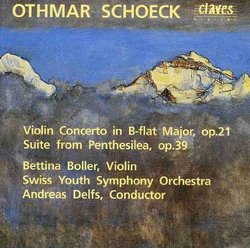| All Artists: Othmar Schoeck, Andreas Delfs, Swiss Youth Symphony Orchestra Title: Othmar Schoek: Violin Concerto in B flat Major Op. 21; Suite from Penthesilea Op. 39 Members Wishing: 0 Total Copies: 0 Label: Claves Original Release Date: 1/1/2008 Re-Release Date: 12/9/2008 Genre: Classical Styles: Opera & Classical Vocal, Forms & Genres, Concertos, Instruments, Strings, Symphonies Number of Discs: 1 SwapaCD Credits: 1 UPCs: 769931920121, 7619931920122, 761993192012 |
Search - Othmar Schoeck, Andreas Delfs, Swiss Youth Symphony Orchestra :: Othmar Schoek: Violin Concerto in B flat Major Op. 21; Suite from Penthesilea Op. 39
 | Othmar Schoeck, Andreas Delfs, Swiss Youth Symphony Orchestra Othmar Schoek: Violin Concerto in B flat Major Op. 21; Suite from Penthesilea Op. 39 Genre: Classical
|
Larger Image |
CD Details |
CD ReviewsAn utterly forgotten masterpiece Philippe Vandenbroeck | HEVERLEE, BELGIUM | 01/02/2010 (5 out of 5 stars) "The Swiss composer Othmar Schoeck wrote a superb violin concerto that will please all amateurs of a mellow, lyrical brand of late-romanticism. It's one of those masterpieces that unexplicably has fallen through the cracks of the mainstream repertoire. I would say it exhibits a level of compositional skill, depth of feeling and sweep of inspiration that is comparable to, say, the Nielsen or the Walton concertos. I personally like it more, and listen to it more often, than the Sibelius concerto (which is not to say that it is technically a better piece).
Schoeck wrote the concerto in 1910/11 when he was only 25 and heavily in (unreciprocated) love with the violin prodigy Stefi Geyer (who was also the dedicatee of Bartok's first concerto). The concerto has been conceived at a grand scale, with an introductory Allegretto that lasts almost fifteen minutes. It is followed by a Grave non troppo lento and a concluding Allegro con spirito. In all, the piece lasts a good deal over half an hour. Stylistically it meanders between the sprightly young Brahms (of the first Serenade) and, particularly in the Grave, the lusciousness of the mature Strauss. The very first bars are magical, with the soloist entering as if 'medias in res' with a spleen-drenched line that seems to weave its way up in the sky casually, yearningly. The tone remains wonderfully lyrical throughout, with the violin being almost constantly at the forefront of a discretely supportive orchestra. The orchestral colouring is muted with husky winds (particularly horns and clarinet) providing occasional relief for the soloist. Schoeck, a composer who essentially directed his oeuvre towards vocal output, once remarked that the violin concerto missed the human voice. But that's only as a figure of speech as the soloist continues to sing and sing throughout this luminous score, quasi una fantasia. The young soloist Bettina Boller filled the bill admirably. The Penthesilea-suite is a very different piece. It is a 25-minute concert suite that has been ably drawn (by Andreas Delfs who conducts this recording) from Schoeck's eponymous one-act opera, written 15 years after the concerto. It was inspired by Heinrich von Kleist's savage 1808 drama, a variation on Homer's Iliad that pitted the Queen of the Amazons against Achilles in lustful and mortal combat. (Hugo Wolf wrote his only symphonic poem from the same provocative material). Predictably, Schoeck's score is much denser and expressionistic than the concerto. An obvious comparison would be Strauss' Elektra but there is also a liberal splash of Janacek's astringent harmonies. Yet the score provides plenty of opportunities for Schoeck to showcase his lyrical gifts. It takes a while but it is really a delightful score, structurally perhaps not terribly coherent but linking together quite ravishing vignettes in which the composer's melodic gift and mastery of the full-blown neoromantic orchestra (including two pianos) is very much in evidence. Given the martial orientation of the story it is perhaps no surprise that there are a number of particularly impressive interventions from the brass (for example, the hair-raising, funereal peroration from the trombones around 5'00" or the wistful horn solo around 9'30" that takes us deep into Mahlerian territory two minutes later). In a blind audition there is nothing that would betray that it is a youth orchestra that is playing these challenging scores. The Swiss Youth Symphony Orchestra does a splendid job, putting down authoritative and (for the Penthesilea) muscled performances. All the more remarkable as none of the desks is older than 25 and the 100-strong ensemble plays purely on a project-basis during school holidays. Hats off to these young musicians and their conductor-coach Andreas Delfs. The music has been taped in 1991 at the well-known concert hall at La-Chaux-de-Fonds. The recording balance is particularly successful in the Penthesilea-suite, with the full-blown orchestra set in a pleasingly airy accoustic. In the concerto the engineers struck a rather less pleasing balance with a close-miked soloist set against a more compact orchestral background. This recording is a lovely production and the care extends to the packaging with a very aptly chosen section from Ferdinand Hodler's hypnotic "Eiger, Mönch and Jungfrau above the sea of mist" as cover. Remarkably, there are no alternatives for both works in the catalogue today, so I would wholeheartedly recommend this recording while it lasts." |

 Track Listings (3) - Disc #1
Track Listings (3) - Disc #1